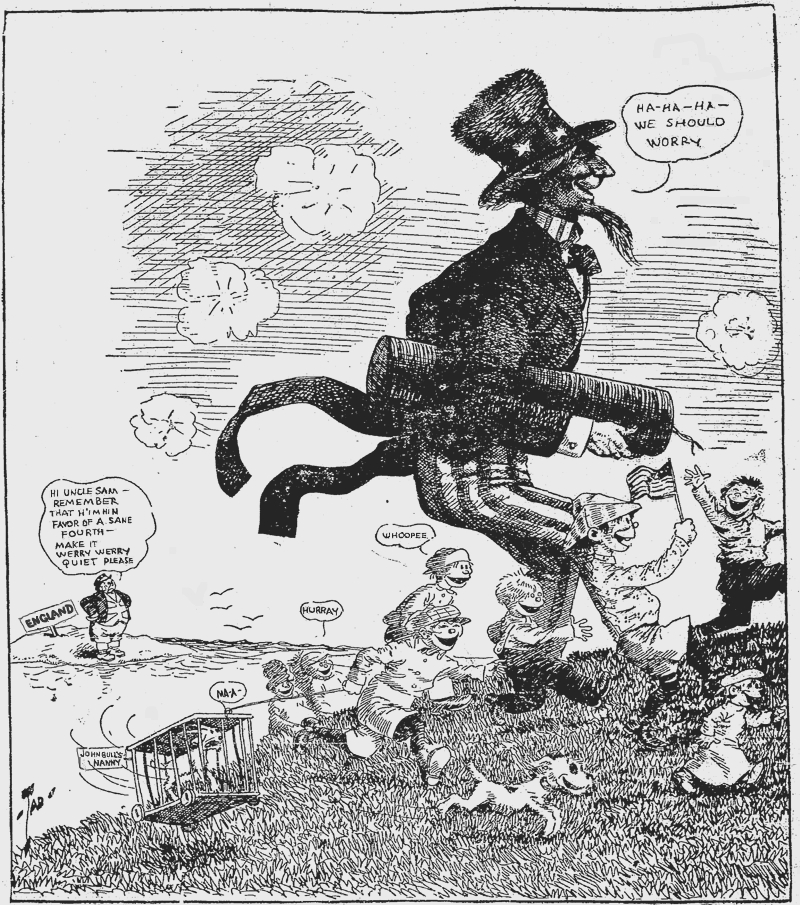
Uncle Sam ignores John Bull and celebrates American Independence with abandon. Seattle Times, 1913
My Seattle Times editorial column, which ran every other Wednesday, seldom fell on the Fourth of July, but in 2012 it did. Usually the month of July was down-time for public controversies, so I would write a column about history. In 2012 I wrote about fireworks in Seattle, 99 years before. It was also an oblique ode to an America, for all its problems, very much worth celebrating.
Today in Seattle, the only legal fireworks are institutional. Personal expression through gunpowder is forbidden. Says the city’s Web page, “Fireworks offenses are gross misdemeanors punishable by up to one year in jail and/or a $5,000 fine.”
Look through the Seattle Times of a century ago and compare attitudes today with the Fourth of July then.
The city had rules about illegal fireworks. On July 4, 1906, Seattle’s chief of police, Charles Wappenstein, announced that the city would no longer tolerate the celebratory shooting of revolvers. Also forbidden, the news story said, were “giant crackers” or “the abominable canes in which bombs are exploded by knocking them against the pavement or the sides of buildings.”
The chief went on to say that “the small boy, and the grown person, too, can have just as much fun and be just as patriotic in using small firecrackers, red fire, Roman candles, skyrockets, etc.”
People ignored fireworks laws then, as now. The Times editorial page of July 4, 1912, referred to the actual Fourth as a booming that begins the day before and “continues until the ammunition is exhausted.”
People expected to have some pyrotechnic joy, and the newspaper celebrated that. On July 4, 1913, The Timesran a drawing of Uncle Sam carrying a firecracker the size of a rolled-up rug. Behind him, in the distance, John Bull yells over from England: “Remember, I’m in favor of a sane Fourth.” Sam laughs. He’s an American, and what real American would care what the English thought?
“The Fourth was a big, big deal in 1912,” says Lorraine McConaghy, historian at Seattle’s Museum of History & Industry. Independence Day was for outings, picnics, baseball and beer. Flags and bunting were everywhere. Men wore flags in lapels. The Bon Marché hung a great flag over Second Avenue.
The flag was important, and Americans were quick to defend it. On July 4, 1913, the top headline in the Timeswas, “FLAG INSULTED IN CANADA!” The “insult” happened
when an American started waving Old Glory at a Canadian Army parade in Winnipeg, and spectators grabbed it and chucked it into the street.
On the same day, a crowd of patriots tore down and trampled the Mexican flag at the consulate in Tucson. The Times had a small story on page 2 about that. It reported the consul demanding an apology from U.S. officials and not receiving one.
On the Fourth, officials were busy giving orations praising America and denouncing its enemies, then chiefly foreign-born anarchists and socialists. There were a lot of them; in the presidential election of 1912, 13 percent of Washington voters supported the Socialist, Eugene Debs. In 1913, assistant U.S. Attorney J.J. Sullivan told a crowd at Madison Park that the Wobblies, who were mainly anarchists, were against the flag and God, and should be deported.
We still have our anarchists, but nobody pays them attention unless they break windows, and then the alarm is about the window-breaking, not the doctrine. The flag incidents probably wouldn’t happen today.
“There is a self-consciousness about Americans now about their place in the world that you don’t see in 1912,” McConaghy says. That’s an improvement.
Whether the ban on fireworks is an improvement I am not so sure. It has made the Fourth safer, but I remember those “giant crackers.” They were dangerous, and I loved them.
© 2012 The Seattle Times
This and similar stories had an influence on me. In 2013 historian Lorraine McConaghy, who is quoted here, asked me to join a project to read Washington newspapers published during the Civil War and make summaries for an historian’s database. That work led directly to my retirement project, which was to research and write a book about the depression of the 1890s in Washington. That book, now published by the Caxton Press, is The Panic of 1893.